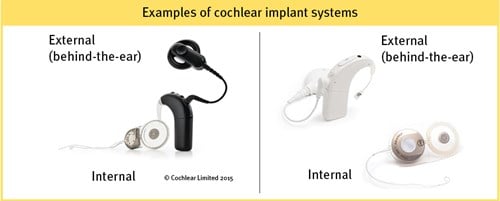Cochlear implants
A cochlear implant is a type of implanted hearing device that converts sound into electrical signals. It is fitted during an operation.
Unlike hearing aids which make sounds louder, a cochlear implant gives a sensation of hearing by directly stimulating the auditory nerves using electrical signals.
The brain perceives sound through a cochlear implant differently than it would with normal hearing. Cochlear implant wearers who have previously heard naturally often describe the sound as being robotic or tinny. However, with time the brain adjusts to the new signals and what it hears becomes more natural sounding.

How cochlear implants work
A cochlear implant has three main parts:
- An external part which hooks over the ear, similar to a hearing aid. This includes the microphone and speech processor.
- An external transmitter coil that is attached to the speech processor by a cable. The transmitter coil is held in place behind the ear by magnetic attraction to the implanted receiver.
- An internal receiver which is surgically implanted under the skin behind the ear.
Some new models of cochlear implant, such as the Cochlear Kanso 2, combine the microphone and speech processor with the external transmitting coil. The whole unit is attached to the head using a magnet, removing the need for an additional part hooked over the ear.
A cochlear implant sends sounds to the brain in these steps:
- The microphone picks up sounds.
- The speech processor converts the sounds into a digital code.
- The digital code is sent to the transmitting coil, which passes through the skin to the internal receiver.
- The internal receiver converts the digital code into an electrical signal.
- The electrical signal is sent along a wire to the electrodes in the cochlea.
- The electrodes stimulate the cochlear nerve fibres, and they send the signal to the brain.
- The brain interprets these sounds so the wearer can understand what was heard.
Diagram 1: Parts of a cochlear implant
Diagram 2: Cochlear implant in place
Who can wear cochlear implants
Cochlear implants are usually suitable for children with severe to profound permanent deafness who gain limited or no benefit from their hearing aids.
It’s now common for children to be implanted before they are 12 months old. This is because evidence suggests that children are more likely to get the most benefit from a cochlear implant the younger they’re implanted. However, it takes time to find out the exact level of a child’s hearing loss and to assess their suitability for a cochlear implant, so some children are implanted later.
Older children can also benefit from cochlear implants, including those who have become deaf after learning to speak (for example, following meningitis). Children with progressive deafness (deafness which gets more severe as they get older) may become eligible for cochlear implants later on. Lots of children who get cochlear implants when they're older still learn to use them well.
How sound is perceived through a cochlear implant
The brain perceives sound through a cochlear implant differently than it would with normal hearing. Cochlear implant wearers who have previously heard naturally often describe the sound as being robotic or tinny. However, with time the brain adjusts to the new signals and what it hears becomes more natural sounding.
We can’t know exactly what the world sounds like to someone using a cochlear implant, and it will vary between people, but there are some simulations available.
The University of Southampton Auditory Implant Service offers simulations of different voices and music. On their website, they include a link to where you can download a program to make your own simulations of sound perception through a cochlear implant.
Want to learn more about cochlear implants?
Become a member for free, and we’ll send you information about the topics you’re most interested in – like hearing technology – tailored for you and your child.
